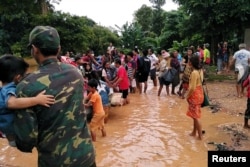A catastrophic dam collapse in Laos has left hundreds missing and thousands homeless with at least several feared dead, according to state media and observers.
The dam "was fractured, and the water had leaked to the downstream area and down to the Xe-Pian River, which is about five kilometers from the dam," said Kijja Sripatthangkura, chief executive officer of Ratchaburi Electricity Generating Holding Company.
Just hours before the disaster on Monday night, the consortium building the project warned in a letter that millions of tons of water would surge down the Xe-Pian River if the dangerously unsafe dam failed.
“And within hours of this letter in the evening, the dam did actually break. So it’s clear that the warning system appears to have been inadequate and appears to have been too late for many people,” Maureen Harris, Southeast Asia director at International Rivers, told VOA.
Some 4,000 people have been displaced downstream from the dam, one of five that make up the Xe-Pian-Xe-Namnoy dam cascade project on the Bolaven Plateau, Harris said.
“And it’s what’s called a saddle dam, meaning it's a supporting dam for a main dam, a primary dam. And it's built to confine the reservoir to enable a higher level of water elevation, a storage which obviously explains, I guess, why there’s so much water that’s been released on the break,” Harris said.
The 410-megawatt project that was set to be completed next year is being built by Xe-Pian Xe-Namnoy Power Company, or PNPC, at an estimated cost of about $1 billion.
The consortium is made up of Korean firms SK Engineering and Construction, and Korea Western Power, as well as Thailand’s Ratchaburi Electricity Generating Holding Company, and Lao Holding State Enterprise.
In their warning letter, PNPC said the saddle dam had become unsafe due to heavy rainfall and would release 5 million tons of water into the Xe Pian River if it failed. The project reservoir is intended to rise 73 meters high by 1,600 meters long, with the capacity to store about 1,043 million cubic meters of water.
State news agency KPL put the number of displaced downstream from the dam in Attapeu province, some 550 kilometers south of the capital, Vientiane, at 6,600.
The Laos Ministry of Natural Resources and Environment has not responded to VOA inquiries, while the Mekong River Commission, the MRC, said it was investigating the disaster and would comment Wednesday.
Videos and photos posted to Facebook by state media showed huge areas inundated and people stranded on the roofs of their flooded houses. Prime Minister Thongloun Sisoulith is pictured visiting the affected area.
The Xe-Pian-Xe-Namnoy dams flow down into the Sekong River through Cambodia, and there are concerns of potential downstream impact.
Monitoring closely
Te Navuth, secretary-general of the Cambodia National Mekong Committee, said they were closely monitoring water levels on the Sekong at a station in Siem Pang, about 80 kilometers from Stung Treng province, which borders Laos.
“The Ministry of Water Resources and Meteorology has already informed local authorities about this disaster and has requested them to watch closely and prepare a resettlement plan for the local people,” Navuth said.
He said they tried many times to get more detailed information but were still waiting for Laos to report to the MRC.
Nuanlaor Wongpinitwarodom, director of Thailand's Mekong Management Bureau, said they were still waiting for more information from Laos. The majority of the power produced by the project is intended for sale on the Thai market.
Water levels across the Mekong region have been rising rapidly since July 15, in one case by more than four meters in the Laotian city of Luang Prabang, due to extremely high rainfall caused by tropical Storm Son-Ting, according to the MRC.
Harris said the incident raised concerns about the risks around dam designs unable to cope with extreme weather events exacerbated by climate change, and the adequacy of warning systems, including for dams currently under construction.
More than 70 dams are currently under construction or planned in Laos, including several on the Mekong mainstream. Harris said the roles and responsibilities of private companies developing these projects should be seriously questioned, in light of the disaster.
“There’s been, I think, at least a couple of other occasions that haven’t been on the scale of this but of dams collapsing or experiencing difficulties because of extreme levels of rain or weather,” she said.
Late last year, the reservoir of the Nam Ao dam in Xaysomboun province in central Laos burst its banks, flooding eight villages with hundreds of thousands of cubic meters of water.
In Cambodia on Tuesday, the owner of a luxury floating resort on the Tatai River in Koh Kong province blasted the Chinese operators of an upstream dam whom he said opened the facility’s floodgates without warning.
Valentin Pawlik, managing partner of 4 Rivers Floating Lodge, alleged in a statement that his resort was smashed into pieces when a surge of water released from the Tatai dam carrying logs smashed into his resort July 17, raising the water level 1.5 meters in two hours.
“Under the combined pressure of the sudden water wave and the pounding of the logs, the 4 Rivers attachment to the shore snapped, and the structure was twisted and broken into six separate pieces,” he wrote.
Zhao Wensheng, deputy general manager of Cambodian Tatay Hydropower Limited, denied his facility was at fault, saying the water released was a small amount within safe margins. Spikes in water levels due to recent heavy rainfall on another tributary of the Tatai had caused surges responsible for the damage, he said.
“We open a little bit, release a little bit [under normal operations]. There's no need to inform anyone,” he said.









